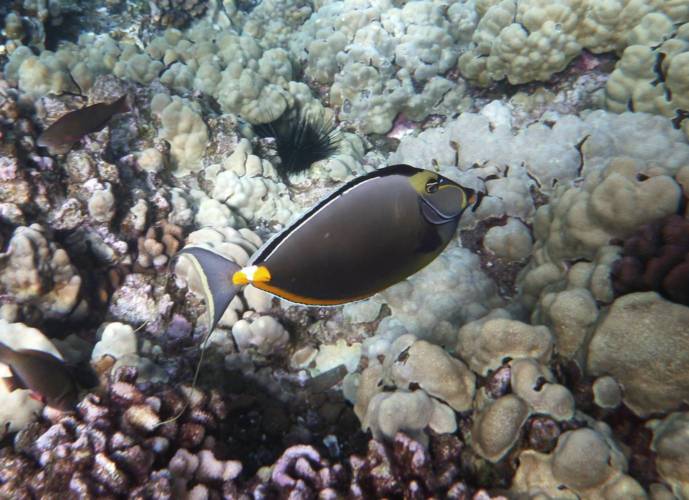Orangeband Surgeonfish
 There are over 80 species of surgeonfish worldwide with 25 of these varieties living in Hawaiian waters. Although they come in many different color variations, they all share the same basic structure. The name “surgeonfish” comes from their hard spines at the base of their tail. They have one spine on each side of their body that lies flat in a groove until the fish is provoked. In times of danger, a surgeonfish will flip its tail and the spines pop out like small knives. They resemble a surgeons’ scalpel, thus the name surgeonfish. The Orangeband Surgeonfish is quickly recognized by its orange spot or band, but it also goes through a fascinating color change as it matures. As a juvenile is solid yellow with just the slightest hint of blue edging the anal and dorsal fins. The adult looks quite different. The front half of a mature specimen (in this picture) is a light gray and the back half is a dark gray. In each case it still retains its shoulder marking, but the orange spot does becomes more brilliant with age. Surgeonfish are herbivores and reside in the shallow waters of the coral reef. They feed on algae, so look for them near rocks that get a lot of filtered sunlight. The Orangeband variety swim in schools along the sandy ocean floor and eat the scraps from other fish. They are like the garbage men of the region.
There are over 80 species of surgeonfish worldwide with 25 of these varieties living in Hawaiian waters. Although they come in many different color variations, they all share the same basic structure. The name “surgeonfish” comes from their hard spines at the base of their tail. They have one spine on each side of their body that lies flat in a groove until the fish is provoked. In times of danger, a surgeonfish will flip its tail and the spines pop out like small knives. They resemble a surgeons’ scalpel, thus the name surgeonfish. The Orangeband Surgeonfish is quickly recognized by its orange spot or band, but it also goes through a fascinating color change as it matures. As a juvenile is solid yellow with just the slightest hint of blue edging the anal and dorsal fins. The adult looks quite different. The front half of a mature specimen (in this picture) is a light gray and the back half is a dark gray. In each case it still retains its shoulder marking, but the orange spot does becomes more brilliant with age. Surgeonfish are herbivores and reside in the shallow waters of the coral reef. They feed on algae, so look for them near rocks that get a lot of filtered sunlight. The Orangeband variety swim in schools along the sandy ocean floor and eat the scraps from other fish. They are like the garbage men of the region.